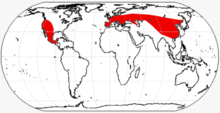| Leptomerycinae Temporal range: Middle Eocene–Middle Miocene PreꞒ Ꞓ O S D C P T J K Pg N | |
|---|---|
| Scientific classification | |
| Domain: | Eukaryota |
| Kingdom: | Animalia |
| Phylum: | Chordata |
| Class: | Mammalia |
| Order: | Artiodactyla |
| Family: | †Leptomerycidae |
| Subfamily: | †Leptomerycinae Zittel, 1893 |
| Genera | |

| |
| Range of Leptomerycinae based on fossil record | |
Leptomerycinae is an extinct subfamily within the ruminant family Leptomerycidae. It contains four genera, Leptomeryx, Pronodens, Pseudoparablastomeryx, and Santuccimeryx, which lived in North America during the Middle Eocene to Middle Miocene. Leptomeryx may also have occurred in Asia during the Early Oligocene. Leptomerycines were primitive and ancient ruminants, resembling small deer or musk deer, although they were more closely related to modern chevrotains.
The genus Santuccimeryx, described as a link between Leptomeryx and Pseudoparablastomeryx, was discovered by ranger paleontologists at Badlands National Park. A skull of the species previously known as Leptomeryx elissae was collected from the park's Oligocene-age Brule Formation, marking the most complete specimen known to date. The presence of both dentary and skull material revealed significant differences from the Leptomeryx genus, prompting the taxonomical overhaul of the subfamily and leading to L. elissae being reclassified into a new genus as Santuccimeryx elissae.
References
- McKenna, M. C.; Bell, S. K. (1997). Classification of Mammals: Above the Species Level. Columbia University Press. p. 631. ISBN 978-0-231-11013-6.
- Shreero, Mattison; Walsh, Ed; Marriott, Katherine; Prothero, Donald R. (May 2024). "A TINY DEER WITH BIG IMPLICATIONS: A NEW GENUS (SANTUCCIMERYX) FROM BADLANDS NATIONAL PARK HELPS BRIDGE THE GAP BETWEEN OLIGOCENE AND MIOCENE LEPTOMERYCIDAE (MAMMALIA, ARTIODACTYLA)". Proceedings of the South Dakota Academy of Science. 102 – via ResearchGate.